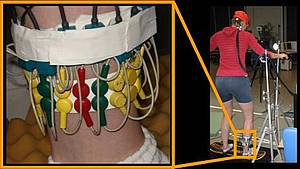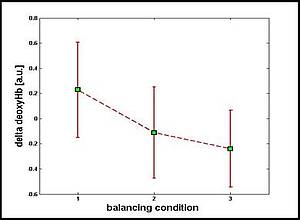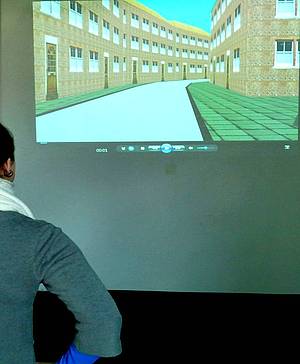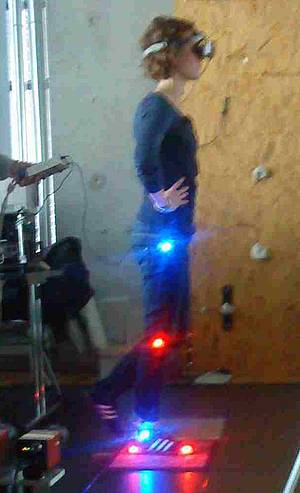Eine Studie über das menschliche Gleichgewicht
Vorbemerkung
Die Idee zu dieser Studie stammt von Aurel Coza (jetzt adidas Portland). Die kombinierten NIRS/EMG/KMP Messungen wurden am Human Performance Center der University of Calgary zusammen mit der damaligen Masterstudentin Heide Boeth (jetzt Charité Berlin) durchgeführt. Die NIRS Messtechnik hat uns freundlicherweise mein Kollege Matthias Kohl-Bareis zur Verfügung gestellt. In unserem Biomechaniklabor in Remagen haben wir Teile der Studie im Rahmen eines Research Projects wiederholt und um Werkzeuge der virtuellen Realität erweitert (z.B. Head Mounted Display). Hier wurden den Probanden während der Balancieraufgabe zusätzlich ein mit unterschiedlicher Frequenz schwankender Horizont präsentiert. Die Ergebnisse der Studie wurden bisher nur in einem Abstract zusammengefasst. Eine Veröffentlichung in einer Fachzeitschrift ist geplant ...
Die Studie
Standing on unstable surfaces is a physically and mentally demanding task. The goal of this study was to quantify the effects of an unstable surface on the activity of the lower leg muscles and the brain areas responsible for the postural control. Thirteen subjects had to fulfill three different balancing tasks of increasing difficulty while standing on a force plate. An EMG array was placed on the lower leg to measure the activity of the small muscles controlling the ankle joint. An optical method based on near infrared spectroscopy (NIRS) was used to record the brain oxygen saturation level.. Multimodal data analysis revealed that the activity of the muscles and the frontal lobe of the brain show a linear relationship with balance task difficulty. The correlation coefficients calculated for every signal combination (EMG-FP, EMG-NIRS, FP-NIRS) show that there is slightly more sensitivity for muscle activity due to perturbation than for frontal brain activity.The human postural control mechanism is one of the most intensely studied biological mechanisms. Despite the large number of studies focusing on this topic the postural control mechanism is still poorly understood and often subject to debate. It is generally agreed, however, that there are three main components responsible for upright posture control: the sensorial system (sensory organs), control system (brain/spine) and the effectors (muscles). Using a mechanical analogy, a generic postural control system consists of a sensory fitted, single or multi-segment body, a control mechanism and a number of actuators. The information flow between these three components is assumed to form a closed or an open loop depending on the task at hand. Experimentally, the functioning of the postural control mechanism can be investigated by quantifying the muscle and brain activity and the correlation between the two. The actual functioning of the postural control mechanism can be investigated by operating systematic changes on usually one of the three components and monitoring the body position changes (sway). While in theory the functioning of any of the three components (sensory, muscles, brain) could be altered, in practice altering the brain and muscles functioning can be a challenging task. Therefore, most of the studies investigating the postural control mechanism would resort to the removal or at least the attenuation of one or more sensorial function(s). While this technique might prove useful in certain instances, it can be argued that it is rarely encountered during normal activity in healthy individuals. A better analogy to most of the daily encountered tasks would be the systematic increase in the difficulty of the postural task while leaving all postural control components unperturbed. Using this approach the postural control system functioning could be studied without making any assumptions regarding the possible impact of an altered system on the system functioning. A similar, albeit more dramatic method, employed to study the control mechanism is the posture perturbation. This approach proved very useful for a better understanding of the process of falling and other similar phenomena. However, the major drawback of this method is the fact that the perturbation is generally singular and does not allow the control mechanism to adapt to this task. Considering these aspects, a continuous perturbation over an extended period of time would be preferred. This could be achieved by performing a balance task on an unstable surface. It is usually assumed that there is a correlation between the task difficulty and the muscle activity. However, this was not shown in the literature. Furthermore, there is controversy regarding the involvement of brain activity in posture stabilization. This might be due to the fact that until recently it has been almost impossible to measure brain activity during complex motor tasks. Neuroscience tools such as fMRI. MEG or PET are barely applicable in the field of biomechanics. For this reason we utilized a rather new technology for the assessment of brain activity based near infrared spectroscopy (NIRS). To the best of our knowledge, there are only a few studies that used NIRS as a tool in biomechanics. Perrey applied a single NIR optode to monitor frontal brain activity during exercise. Mihara et al. used a NIR imaging (NIRI) device in order to localize brain activity only for a single unexpected perturbation of balance. As far as we can see no study has been published presenting a synchronous assessment of brain and muscle activity for a complex motor task. Finally, the goals of this study can be summarized as follows:(a) quantifying the influence of balance task difficulty on brain and lower leg muscles activity and (b) analyzing possible correlations between muscle activity, brain activity and task difficulty during balance tasks.
The hypotheses of this study are: (a) increased balance task difficulty will increase the brain and muscle activity and (b) a correlation exists between task difficulty, brain activity and muscle activity.













